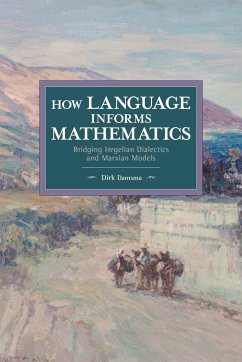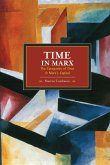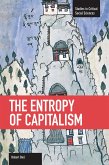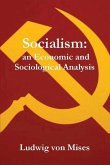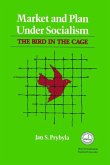- Broschiertes Buch
- Merkliste
- Auf die Merkliste
- Bewerten Bewerten
- Teilen
- Produkt teilen
- Produkterinnerung
- Produkterinnerung
Most economic model building intentionally ignores political and social reality; Damsma makes a compelling case for an alternative approach.
Andere Kunden interessierten sich auch für
![Time in Marx Time in Marx]() Stavros TombazosTime in Marx37,99 €
Stavros TombazosTime in Marx37,99 €![The Corporation, Law, and Capitalism The Corporation, Law, and Capitalism]() Grietje BaarsThe Corporation, Law, and Capitalism49,99 €
Grietje BaarsThe Corporation, Law, and Capitalism49,99 €![Marx on Capitalism Marx on Capitalism]() James FurnerMarx on Capitalism54,99 €
James FurnerMarx on Capitalism54,99 €![The Entropy of Capitalism The Entropy of Capitalism]() Robert Biel MThe Entropy of Capitalism42,99 €
Robert Biel MThe Entropy of Capitalism42,99 €![Socialism: An Economic and Sociological Analysis Socialism: An Economic and Sociological Analysis]() Ludwig Von MisesSocialism: An Economic and Sociological Analysis23,99 €
Ludwig Von MisesSocialism: An Economic and Sociological Analysis23,99 €![Market and Plan Under Socialism Market and Plan Under Socialism]() Jan S PrybylaMarket and Plan Under Socialism10,99 €
Jan S PrybylaMarket and Plan Under Socialism10,99 €![Marx's Theory of the Genesis of Money Marx's Theory of the Genesis of Money]() Samez Kuruma &Marx's Theory of the Genesis of Money33,99 €
Samez Kuruma &Marx's Theory of the Genesis of Money33,99 €-
-
-
Most economic model building intentionally ignores political and social reality; Damsma makes a compelling case for an alternative approach.
Hinweis: Dieser Artikel kann nur an eine deutsche Lieferadresse ausgeliefert werden.
Hinweis: Dieser Artikel kann nur an eine deutsche Lieferadresse ausgeliefert werden.
Produktdetails
- Produktdetails
- Verlag: Haymarket Books
- Seitenzahl: 250
- Erscheinungstermin: 6. Oktober 2020
- Englisch
- Abmessung: 226mm x 150mm x 15mm
- Gewicht: 318g
- ISBN-13: 9781642591866
- ISBN-10: 1642591866
- Artikelnr.: 57834229
- Herstellerkennzeichnung
- Libri GmbH
- Europaallee 1
- 36244 Bad Hersfeld
- gpsr@libri.de
- Verlag: Haymarket Books
- Seitenzahl: 250
- Erscheinungstermin: 6. Oktober 2020
- Englisch
- Abmessung: 226mm x 150mm x 15mm
- Gewicht: 318g
- ISBN-13: 9781642591866
- ISBN-10: 1642591866
- Artikelnr.: 57834229
- Herstellerkennzeichnung
- Libri GmbH
- Europaallee 1
- 36244 Bad Hersfeld
- gpsr@libri.de
Dirk Damsma, Ph.D. (2015), University of Amsterdam, is Lecturer of Economic Methodology and Thesis Coordinator at that university. He has published "Set Theory and Geometry in Hegel" in Hegel Jahrbuch 2011. This book is an improved rendition of his dissertation.
List of Figure and Tables
Acknowledgements
Brief Contents
Note on the Style of Referencing and the Use of Capitalisation and Emphasis
in this Work
List of Symbols
Introduction
1 On Marx's and Hegel's Dialectical Methods
Introduction
1 The Chronology of Hegel's and Marx's Historical and Systematic Dialectic
2 Hegel's Method
3 Marx's Comments on Hegel, Their Implications and Marx's Twist on Hegel's
Dialectical Method
4 Commentators on and Studies of Marx's Dialectics
Summary and Conclusions
Preview
2 The Dialectical Foundations of Mathematics
Introduction
1 Previous Literature on Hegel and Mathematics
2 Hegel's Determination of the Quantitative
A Quality
2.1 Being
2.2 Nothing
2.3 Becoming
2.4 Presence
2.5 Something and Other
2.6 One and Many Ones
2.7 Attraction and Repulsion
B Quantity
2.8 Quantity
2.9 Continuous and Discrete Magnitude
2.10 Quantum and Number
2.11 Unit and Amount
2.12 Limit
2.13 Intensive and Extensive Magnitude
C Measure
2.14 Measure
3 Hegel's Determination of Mathematical Mechanics
A Space and Time
3.1 Space
3.2 Spatial Dimensions
3.3 The Point
3.4 The Line
3.5 The Plane
3.6 Distinct Space
3.7 Time
3.8 Temporal Dimensions
3.9 Now
3.10 Place
3.11 Motion
3.12 Matter
Summary and Conclusions: How This Dialectic Reflects on Mathematics
Appendix: Comparison of the Determination of the Quantitative in the
Wissenschaft and the Encyclopädie
A1 Being, Nothing, Becoming, Presence, Something and Others
A2 Qualitative Limit
A3 Finitude and Infinity
A4 True Infinite
A5 Being-for-self
A6 One, Many Ones, Repulsion, Attraction, Quantity, Continuous and Discrete
Magnitude, Quantum, Number, Unit and Amount, Quantitative Limit and
Intensive and Extensive Magnitude
A7 Quantitative Infinity
A8 Direct Ratio
A9 Inverse Ratio
A10 Ratio of Powers
A11 Measure
Concluding Remarks
3 Marx's Systematic Dialectics and Mathematics
Introduction
1 Marx's Acquaintance with and Ideas on Mathematics
2 Marx's Exhibition of Capitalism as a System: The Systematic-Dialectical
Position
2.1 Sociation
2.2 Dissociation
2.3 Association: The Exchange Relation
2.4 The Commodity, Exchangeability and the Bargain
2.5 Value in Exchange
2.6 The Simple, Expanded and General Commodity Form and the Money Form of
Value
2.7 Money as Measure of Value, Means of Circulation and End of Exchange
2.8 Capital
2.9 Constant and Variable Capital
2.10 Accumulation
2.11 The Money Capital, Production Capital and Commodity Capital Circuits
2.12 Fixed and Circulating Capital
2.13 Simple Reproduction, Means of Production, Consumption Goods, Total
Social Capital and Expanded Reproduction
2.14 General Rate of Profit, Many Capitals, Competition and Minimum Prices
of Production
3 The Role of Mathematics in Marx's Investigation and Exhibition in
Capital: the Case of Marx's 'Schemes of Reproduction'
3.1 Simple Reproduction
3.1.1 The Model
3.1.2 Conclusions
3.2 Expanded Reproduction
3.2.1 The Model
3.2.2 Conclusions
Summary and Conclusions on the Role of Mathematics in
Systematic-Dialectical Investigation and Exhibition
4 A Formal Dynamic Reconstruction of Marx's Schemes of Reproduction along
Dialectical Lines
Introduction
1 The Model for Simple Reproduction
2 Extensive Growth of Total Social Capital
3 The Model for Expanded Reproduction
Summary and Conclusions
Appendix: Derivations
A1 Accumulation and Growth Rate for Department c as a Function of
Accumulation and Growth in Department p with Extensive Growth (expression
4.15 and 4.16)
A2 Constant Capital's Growth Rate for Department c for the Case of Expanded
Reproduction (expression 4.19)
A3 The Condition for Constant Rates of Accumulation in Case of Expanded
Reproduction (expression 4.20)
Summary and General Conclusions
References
Author Index
Subject Index
Acknowledgements
Brief Contents
Note on the Style of Referencing and the Use of Capitalisation and Emphasis
in this Work
List of Symbols
Introduction
1 On Marx's and Hegel's Dialectical Methods
Introduction
1 The Chronology of Hegel's and Marx's Historical and Systematic Dialectic
2 Hegel's Method
3 Marx's Comments on Hegel, Their Implications and Marx's Twist on Hegel's
Dialectical Method
4 Commentators on and Studies of Marx's Dialectics
Summary and Conclusions
Preview
2 The Dialectical Foundations of Mathematics
Introduction
1 Previous Literature on Hegel and Mathematics
2 Hegel's Determination of the Quantitative
A Quality
2.1 Being
2.2 Nothing
2.3 Becoming
2.4 Presence
2.5 Something and Other
2.6 One and Many Ones
2.7 Attraction and Repulsion
B Quantity
2.8 Quantity
2.9 Continuous and Discrete Magnitude
2.10 Quantum and Number
2.11 Unit and Amount
2.12 Limit
2.13 Intensive and Extensive Magnitude
C Measure
2.14 Measure
3 Hegel's Determination of Mathematical Mechanics
A Space and Time
3.1 Space
3.2 Spatial Dimensions
3.3 The Point
3.4 The Line
3.5 The Plane
3.6 Distinct Space
3.7 Time
3.8 Temporal Dimensions
3.9 Now
3.10 Place
3.11 Motion
3.12 Matter
Summary and Conclusions: How This Dialectic Reflects on Mathematics
Appendix: Comparison of the Determination of the Quantitative in the
Wissenschaft and the Encyclopädie
A1 Being, Nothing, Becoming, Presence, Something and Others
A2 Qualitative Limit
A3 Finitude and Infinity
A4 True Infinite
A5 Being-for-self
A6 One, Many Ones, Repulsion, Attraction, Quantity, Continuous and Discrete
Magnitude, Quantum, Number, Unit and Amount, Quantitative Limit and
Intensive and Extensive Magnitude
A7 Quantitative Infinity
A8 Direct Ratio
A9 Inverse Ratio
A10 Ratio of Powers
A11 Measure
Concluding Remarks
3 Marx's Systematic Dialectics and Mathematics
Introduction
1 Marx's Acquaintance with and Ideas on Mathematics
2 Marx's Exhibition of Capitalism as a System: The Systematic-Dialectical
Position
2.1 Sociation
2.2 Dissociation
2.3 Association: The Exchange Relation
2.4 The Commodity, Exchangeability and the Bargain
2.5 Value in Exchange
2.6 The Simple, Expanded and General Commodity Form and the Money Form of
Value
2.7 Money as Measure of Value, Means of Circulation and End of Exchange
2.8 Capital
2.9 Constant and Variable Capital
2.10 Accumulation
2.11 The Money Capital, Production Capital and Commodity Capital Circuits
2.12 Fixed and Circulating Capital
2.13 Simple Reproduction, Means of Production, Consumption Goods, Total
Social Capital and Expanded Reproduction
2.14 General Rate of Profit, Many Capitals, Competition and Minimum Prices
of Production
3 The Role of Mathematics in Marx's Investigation and Exhibition in
Capital: the Case of Marx's 'Schemes of Reproduction'
3.1 Simple Reproduction
3.1.1 The Model
3.1.2 Conclusions
3.2 Expanded Reproduction
3.2.1 The Model
3.2.2 Conclusions
Summary and Conclusions on the Role of Mathematics in
Systematic-Dialectical Investigation and Exhibition
4 A Formal Dynamic Reconstruction of Marx's Schemes of Reproduction along
Dialectical Lines
Introduction
1 The Model for Simple Reproduction
2 Extensive Growth of Total Social Capital
3 The Model for Expanded Reproduction
Summary and Conclusions
Appendix: Derivations
A1 Accumulation and Growth Rate for Department c as a Function of
Accumulation and Growth in Department p with Extensive Growth (expression
4.15 and 4.16)
A2 Constant Capital's Growth Rate for Department c for the Case of Expanded
Reproduction (expression 4.19)
A3 The Condition for Constant Rates of Accumulation in Case of Expanded
Reproduction (expression 4.20)
Summary and General Conclusions
References
Author Index
Subject Index
List of Figure and Tables
Acknowledgements
Brief Contents
Note on the Style of Referencing and the Use of Capitalisation and Emphasis
in this Work
List of Symbols
Introduction
1 On Marx's and Hegel's Dialectical Methods
Introduction
1 The Chronology of Hegel's and Marx's Historical and Systematic Dialectic
2 Hegel's Method
3 Marx's Comments on Hegel, Their Implications and Marx's Twist on Hegel's
Dialectical Method
4 Commentators on and Studies of Marx's Dialectics
Summary and Conclusions
Preview
2 The Dialectical Foundations of Mathematics
Introduction
1 Previous Literature on Hegel and Mathematics
2 Hegel's Determination of the Quantitative
A Quality
2.1 Being
2.2 Nothing
2.3 Becoming
2.4 Presence
2.5 Something and Other
2.6 One and Many Ones
2.7 Attraction and Repulsion
B Quantity
2.8 Quantity
2.9 Continuous and Discrete Magnitude
2.10 Quantum and Number
2.11 Unit and Amount
2.12 Limit
2.13 Intensive and Extensive Magnitude
C Measure
2.14 Measure
3 Hegel's Determination of Mathematical Mechanics
A Space and Time
3.1 Space
3.2 Spatial Dimensions
3.3 The Point
3.4 The Line
3.5 The Plane
3.6 Distinct Space
3.7 Time
3.8 Temporal Dimensions
3.9 Now
3.10 Place
3.11 Motion
3.12 Matter
Summary and Conclusions: How This Dialectic Reflects on Mathematics
Appendix: Comparison of the Determination of the Quantitative in the
Wissenschaft and the Encyclopädie
A1 Being, Nothing, Becoming, Presence, Something and Others
A2 Qualitative Limit
A3 Finitude and Infinity
A4 True Infinite
A5 Being-for-self
A6 One, Many Ones, Repulsion, Attraction, Quantity, Continuous and Discrete
Magnitude, Quantum, Number, Unit and Amount, Quantitative Limit and
Intensive and Extensive Magnitude
A7 Quantitative Infinity
A8 Direct Ratio
A9 Inverse Ratio
A10 Ratio of Powers
A11 Measure
Concluding Remarks
3 Marx's Systematic Dialectics and Mathematics
Introduction
1 Marx's Acquaintance with and Ideas on Mathematics
2 Marx's Exhibition of Capitalism as a System: The Systematic-Dialectical
Position
2.1 Sociation
2.2 Dissociation
2.3 Association: The Exchange Relation
2.4 The Commodity, Exchangeability and the Bargain
2.5 Value in Exchange
2.6 The Simple, Expanded and General Commodity Form and the Money Form of
Value
2.7 Money as Measure of Value, Means of Circulation and End of Exchange
2.8 Capital
2.9 Constant and Variable Capital
2.10 Accumulation
2.11 The Money Capital, Production Capital and Commodity Capital Circuits
2.12 Fixed and Circulating Capital
2.13 Simple Reproduction, Means of Production, Consumption Goods, Total
Social Capital and Expanded Reproduction
2.14 General Rate of Profit, Many Capitals, Competition and Minimum Prices
of Production
3 The Role of Mathematics in Marx's Investigation and Exhibition in
Capital: the Case of Marx's 'Schemes of Reproduction'
3.1 Simple Reproduction
3.1.1 The Model
3.1.2 Conclusions
3.2 Expanded Reproduction
3.2.1 The Model
3.2.2 Conclusions
Summary and Conclusions on the Role of Mathematics in
Systematic-Dialectical Investigation and Exhibition
4 A Formal Dynamic Reconstruction of Marx's Schemes of Reproduction along
Dialectical Lines
Introduction
1 The Model for Simple Reproduction
2 Extensive Growth of Total Social Capital
3 The Model for Expanded Reproduction
Summary and Conclusions
Appendix: Derivations
A1 Accumulation and Growth Rate for Department c as a Function of
Accumulation and Growth in Department p with Extensive Growth (expression
4.15 and 4.16)
A2 Constant Capital's Growth Rate for Department c for the Case of Expanded
Reproduction (expression 4.19)
A3 The Condition for Constant Rates of Accumulation in Case of Expanded
Reproduction (expression 4.20)
Summary and General Conclusions
References
Author Index
Subject Index
Acknowledgements
Brief Contents
Note on the Style of Referencing and the Use of Capitalisation and Emphasis
in this Work
List of Symbols
Introduction
1 On Marx's and Hegel's Dialectical Methods
Introduction
1 The Chronology of Hegel's and Marx's Historical and Systematic Dialectic
2 Hegel's Method
3 Marx's Comments on Hegel, Their Implications and Marx's Twist on Hegel's
Dialectical Method
4 Commentators on and Studies of Marx's Dialectics
Summary and Conclusions
Preview
2 The Dialectical Foundations of Mathematics
Introduction
1 Previous Literature on Hegel and Mathematics
2 Hegel's Determination of the Quantitative
A Quality
2.1 Being
2.2 Nothing
2.3 Becoming
2.4 Presence
2.5 Something and Other
2.6 One and Many Ones
2.7 Attraction and Repulsion
B Quantity
2.8 Quantity
2.9 Continuous and Discrete Magnitude
2.10 Quantum and Number
2.11 Unit and Amount
2.12 Limit
2.13 Intensive and Extensive Magnitude
C Measure
2.14 Measure
3 Hegel's Determination of Mathematical Mechanics
A Space and Time
3.1 Space
3.2 Spatial Dimensions
3.3 The Point
3.4 The Line
3.5 The Plane
3.6 Distinct Space
3.7 Time
3.8 Temporal Dimensions
3.9 Now
3.10 Place
3.11 Motion
3.12 Matter
Summary and Conclusions: How This Dialectic Reflects on Mathematics
Appendix: Comparison of the Determination of the Quantitative in the
Wissenschaft and the Encyclopädie
A1 Being, Nothing, Becoming, Presence, Something and Others
A2 Qualitative Limit
A3 Finitude and Infinity
A4 True Infinite
A5 Being-for-self
A6 One, Many Ones, Repulsion, Attraction, Quantity, Continuous and Discrete
Magnitude, Quantum, Number, Unit and Amount, Quantitative Limit and
Intensive and Extensive Magnitude
A7 Quantitative Infinity
A8 Direct Ratio
A9 Inverse Ratio
A10 Ratio of Powers
A11 Measure
Concluding Remarks
3 Marx's Systematic Dialectics and Mathematics
Introduction
1 Marx's Acquaintance with and Ideas on Mathematics
2 Marx's Exhibition of Capitalism as a System: The Systematic-Dialectical
Position
2.1 Sociation
2.2 Dissociation
2.3 Association: The Exchange Relation
2.4 The Commodity, Exchangeability and the Bargain
2.5 Value in Exchange
2.6 The Simple, Expanded and General Commodity Form and the Money Form of
Value
2.7 Money as Measure of Value, Means of Circulation and End of Exchange
2.8 Capital
2.9 Constant and Variable Capital
2.10 Accumulation
2.11 The Money Capital, Production Capital and Commodity Capital Circuits
2.12 Fixed and Circulating Capital
2.13 Simple Reproduction, Means of Production, Consumption Goods, Total
Social Capital and Expanded Reproduction
2.14 General Rate of Profit, Many Capitals, Competition and Minimum Prices
of Production
3 The Role of Mathematics in Marx's Investigation and Exhibition in
Capital: the Case of Marx's 'Schemes of Reproduction'
3.1 Simple Reproduction
3.1.1 The Model
3.1.2 Conclusions
3.2 Expanded Reproduction
3.2.1 The Model
3.2.2 Conclusions
Summary and Conclusions on the Role of Mathematics in
Systematic-Dialectical Investigation and Exhibition
4 A Formal Dynamic Reconstruction of Marx's Schemes of Reproduction along
Dialectical Lines
Introduction
1 The Model for Simple Reproduction
2 Extensive Growth of Total Social Capital
3 The Model for Expanded Reproduction
Summary and Conclusions
Appendix: Derivations
A1 Accumulation and Growth Rate for Department c as a Function of
Accumulation and Growth in Department p with Extensive Growth (expression
4.15 and 4.16)
A2 Constant Capital's Growth Rate for Department c for the Case of Expanded
Reproduction (expression 4.19)
A3 The Condition for Constant Rates of Accumulation in Case of Expanded
Reproduction (expression 4.20)
Summary and General Conclusions
References
Author Index
Subject Index

